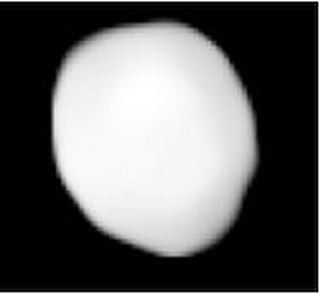
Europa is the 6th-largest asteroid in the asteroid belt, having a diameter of over 300 km, though it is not correspondingly massive. It is not round but is shaped like an ellipsoid of approximately 380×330×250 km. It was discovered on 4 February 1858, by Hermann Goldschmidt from his balcony in Paris. It is named after Europa, one of Zeus's conquests in Greek mythology, a name it shares with Jupiter's moon Europa.
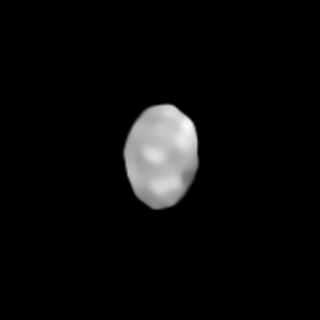
16 Psyche is a large M-type asteroid, which was discovered by the Italian astronomer Annibale de Gasparis, on 17 March 1852 and named after the Greek goddess Psyche. The prefix "16" signifies that it was the sixteenth minor planet in order of discovery. It is the largest and most massive of the M-type asteroids, and one of the dozen most massive asteroids. It has a mean diameter of approximately 220 kilometers (140 mi) and contains about one percent of the mass of the asteroid belt. It was thought to be the exposed core of a protoplanet, but recent observations cast doubt on that hypothesis. Psyche will be explored by NASA, with a spacecraft of the same name, marking the first time a manmade object will journey to a metallic asteroid, launched on 13 October 2023, with an expected arrival in 2029.
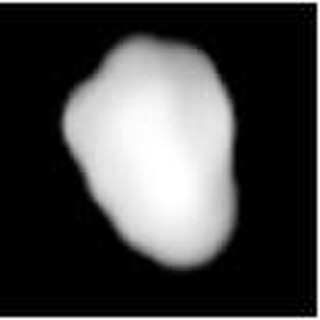
Metis is one of the larger main-belt asteroids. It is composed of silicates and metallic nickel-iron, and may be the core remnant of a large asteroid that was destroyed by an ancient collision. Metis is estimated to contain just under half a percent of the total mass of the asteroid belt.

Hygiea is a major asteroid located in the main asteroid belt. With a mean diameter of between 425 and 440 km and a mass estimated to be 3% of the total mass of the belt, it is the fourth-largest asteroid in the Solar System by both volume and mass, and is the largest of the C-type asteroids in classifications that use G type for 1 Ceres. It is very close to spherical, apparently because it had re-accreted after the disruptive impact that produced the large Hygiean family of asteroids.
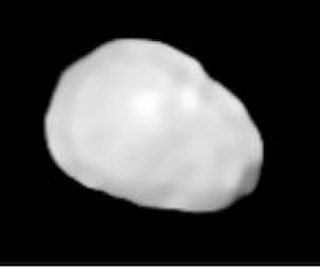
Eunomia is a very large asteroid in the middle asteroid belt. It is the largest of the stony (S-type) asteroids, with 3 Juno as a close second. It is quite a massive asteroid, in 6th to 8th place. It is the largest Eunomian asteroid, and is estimated to contain 1% of the mass of the asteroid belt.
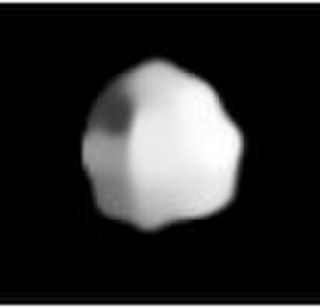
Melpomene is a large, bright main-belt asteroid that was discovered by J. R. Hind on 24 June 1852, and named after Melpomenē, the Muse of tragedy in Greek mythology. Its historical symbol was a dagger over a star; it is in the pipeline for Unicode 17.0 as U+1CECB .

Amphitrite is one of the largest S-type asteroids, approximately 200 kilometers in diameter, and probably fifth largest after Eunomia, Juno, Iris and Herculina.
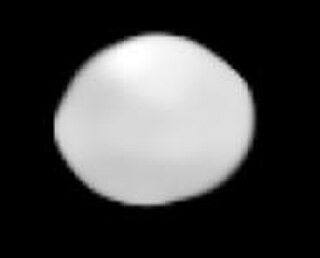
Euphrosyne is a very young asteroid. It is one of the largest asteroids. It was discovered by James Ferguson on September 1, 1854, the first asteroid found from North America. It is named after Euphrosyne, one of the Charites in Greek mythology. In 2019 a small companion was discovered. It is the third-roundest known asteroid ; this is thought to be due to having re-accreted after being disrupted by a collision, and it is not close to hydrostatic equilibrium.

Leda is a large, dark main-belt asteroid that was discovered by French astronomer J. Chacornac on January 12, 1856, and named after Leda, the mother of Helen of Troy in Greek mythology. In the Tholen classification system, it is categorized as a carbonaceous C-type asteroid, while the Bus asteroid taxonomy system lists it as a Cgh asteroid. The spectra of the asteroid displays evidence of aqueous alteration.
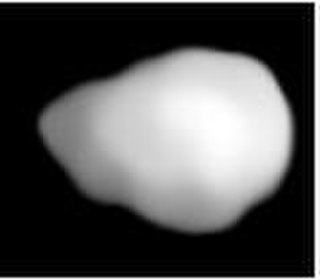
Daphne is a large asteroid from the asteroid belt. It is a dark-surfaced body 174 km in diameter is probably composed of primitive carbonaceous chondrites. The spectra of the asteroid displays evidence of aqueous alteration. It was discovered by H. Goldschmidt on May 22, 1856, and named after Daphne, the nymph in Greek mythology who was turned into a laurel tree. Incorrect orbital calculations initially resulted in 56 Melete being mistaken for a second sighting of Daphne. Daphne was not sighted again until August 31, 1862.
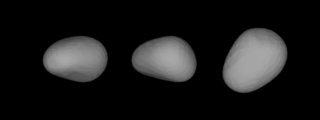
Nysa is a large and very bright main-belt asteroid, and the brightest member of the Nysian asteroid family. It is classified as a rare class E asteroid and is probably the largest of this type.
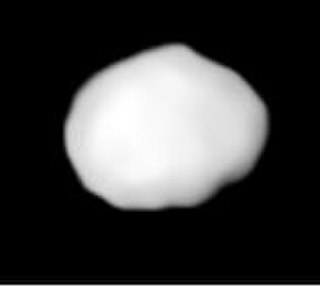
Thisbe, minor planet designation 88 Thisbe, is the 13th largest main-belt asteroid. It was discovered by C. H. F. Peters on June 15, 1866, and named after Thisbe, heroine of a Roman fable. This asteroid is orbiting the Sun at a distance of 2.768 AU with a period of 4.60 years and an orbital eccentricity (ovalness) of 0.165. The orbital plane is inclined at an angle of 5.219° to the ecliptic.

137 Meliboea is a large, dark main-belt asteroid that was discovered by Austrian astronomer J. Palisa at the Austrian Naval Observatory on 21 April 1874, the second of his many asteroid discoveries. It was later named after Meliboea, the daughter of Oceanus and Tethys in Greek mythology. The largest body in the Meliboea family of asteroids that share similar orbital elements, only 791 Ani approaches its size. It is classified as a C-type asteroid and may be composed of carbonaceous materials. The spectra of the asteroid displays evidence of aqueous alteration.
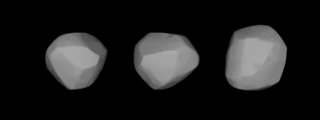
Lucina is a main-belt asteroid that was discovered by Alphonse Borrelly on June 8, 1875, and named after Lucina, the Roman goddess of childbirth. It is large, dark and has a carbonaceous composition. The spectra of the asteroid displays evidence of aqueous alteration.
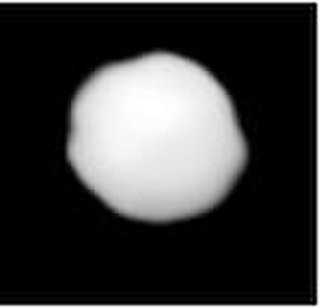
Adeona is a large asteroid from the intermediate asteroid belt, approximately 150 kilometers in diameter. Its surface is very dark, and, based upon its classification as a C-type asteroid, is probably composed of primitive carbonaceous material. The spectra of the asteroid displays evidence of aqueous alteration. The Adeona family of asteroids is named after it.
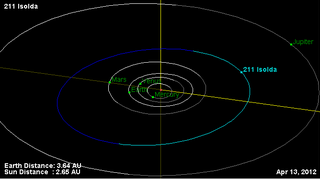
Isolda is a very large, dark main-belt asteroid. It is classified as a C-type asteroid and is probably composed of primitive carbonaceous material. The spectra of the asteroid displays evidence of aqueous alteration.

Polyxo is a main-belt asteroid that was discovered by A. Borrelly on March 31, 1891, in Marseilles. It is orbiting the Sun at a distance of 2.75 AU with a low orbital eccentricity (ovalness) of 0.04 and a period of 4.56 yr. The orbital plane is tilted at an angle of 4.36° to the plane of the ecliptic.
Gyptis, minor planet designation: 444 Gyptis, is a main-belt asteroid that was discovered by J. Coggia on March 31, 1899, in Marseilles. It is classified as a C-type asteroid and is probably composed of carbonaceous material. The spectra of the asteroid displays evidence of aqueous alteration.
Kreusa is a C-type asteroid orbiting the Sun in the asteroid belt, with the type indicating a surface with a low albedo and high carbonaceous content. The spectra of the asteroid displays evidence of aqueous alteration.
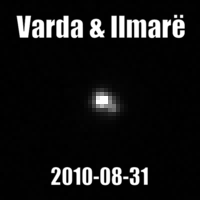
174567 Varda (provisional designation 2003 MW12) is a binary trans-Neptunian planetoid of the resonant hot classical population of the Kuiper belt, located in the outermost region of the Solar System. Its moon, Ilmarë, was discovered in 2009.

![]() ). [11] [12]
). [11] [12] 
















